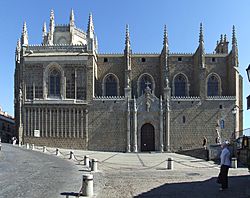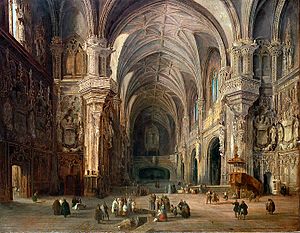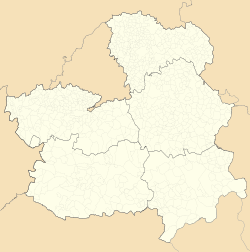Monastery of San Juan de los Reyes facts for kids

Monastery of San Juan de los Reyes
|
|
| Monastery information | |
|---|---|
| Other names | San Juan de la Reyna |
| Dedicated to | Saint John the Evangelist |
| People | |
| Founder(s) | King Ferdinand II of Aragon and Queen Isabella I of Castile |
| Architecture | |
| Architect | Juan Guas |
| Style | Isabelline |
| Groundbreaking | 1477 |
| Completion date | 1504 |
| Site | |
| Location | |
| Coordinates | 39°51′28″N 4°1′54″W / 39.85778°N 4.03167°W |
The Monastery of San Juan de los Reyes is a beautiful old monastery in Toledo, Spain. It was built a long time ago by King Ferdinand II of Aragon and Queen Isabella I of Castile, who are often called the Catholic Monarchs. This special building was finished in 1504 and shows off a unique Spanish building style called Isabelline.
Contents
Why the Monastery Was Built
This monastery was started by King Ferdinand II and Queen Isabella I. They wanted to celebrate two important things. First, it marked the birth of their son, Prince John. Second, it honored their victory at the Battle of Toro in 1476. This battle was fought against the army of Afonso V of Portugal.
The Battle of Toro was a very important moment for the Catholic Monarchs. Even though the battle itself had a mixed outcome, it helped them secure their place on the throne. It also helped pave the way for the future united kingdoms of Spain. A historian named Rafael Casas said that the monastery was built to remember this battle. It was a battle with an "uncertain outcome" but was "decisive" for uniting the two most important kingdoms in Spain.
Toledo was chosen as the place for the monastery because it was in the center of Spain. It had also been the capital of an old kingdom called the Visigoth kingdom. Building the monastery there helped symbolize the new unity of Spain under Isabella and Ferdinand.
A Look at Its History

This monastery was first called "San Juan de la Reyna." It was planned to be the burial place for the Catholic Monarchs. However, they later changed their minds. They chose Granada as their final resting place after they took it back in 1492.
Building the monastery began in 1477. The plans were drawn by an architect named Juan Guas. The construction was finished in 1504. The monastery was dedicated to Saint John the Evangelist. It was used by Franciscan friars, who are a type of religious order.
In 1809, the monastery was badly damaged. This happened when Napoleon's troops occupied Toledo. The monastery was then left empty in 1835. Work to fix it started in 1883 but wasn't finished until 1967. The Franciscan order was able to use the monastery again in 1954.
What the Monastery Looks Like
The Monastery of San Juan de los Reyes is a great example of the Isabelline style. This style is known for its detailed decorations. The church inside the monastery is shaped like a Latin cross. It has a long main area, called a nave, which is about 50 meters long and 30 meters high. There are also small chapels on the sides.
The church is famous for its decorations. You can see the coats of arms of the Catholic Monarchs held by eagles. The main altar in the church was made in the mid-1500s. It shows scenes from the life of Jesus, like the Passion and the Resurrection.
The monastery also has a beautiful cloister, which is an open courtyard with covered walkways. It has a small garden. The ceiling of the ground floor has interesting designs. These include figures of saints mixed with animals and plants. These were made by a sculptor named Cecilio Béjar in the 20th century.
The upper cloisters were finished in 1526. They were repaired in the 1800s. These areas have Mudéjar decorations. This is a style that mixes Christian and Islamic art. The ceiling here is made of larch wood. It is painted with designs and the coats of arms of the Catholic Monarchs. It also has their motto, Tanto monta, monta tanto.
A special feature on the outside of the monastery is its granite facade. It is decorated with manacles and shackles. These were worn by Christian prisoners who were held by the Moors in Granada. Queen Isabella ordered these to be placed there in 1494. They symbolize the freedom of these prisoners during the Reconquista, which was the time when Christian kingdoms took back control of Spain.
Images for kids
-
Detail of Mudéjar ceiling in the cloister
See also
 In Spanish: Monasterio de San Juan de los Reyes para niños
In Spanish: Monasterio de San Juan de los Reyes para niños










